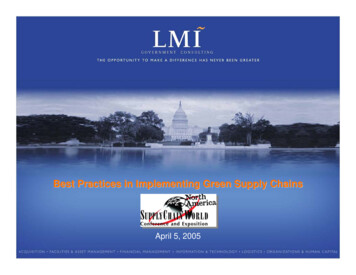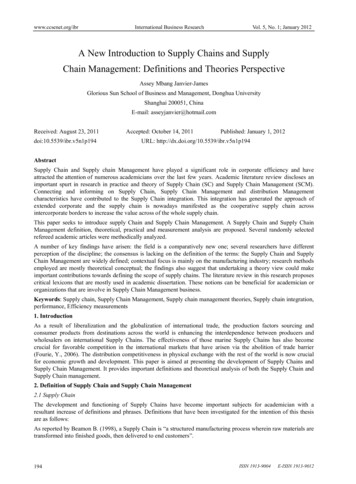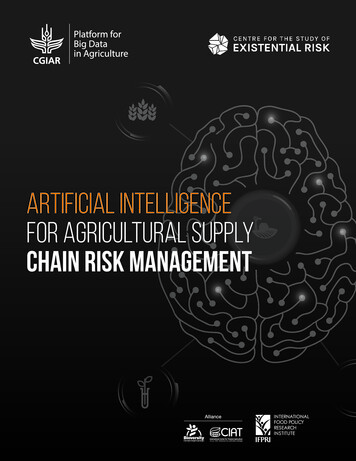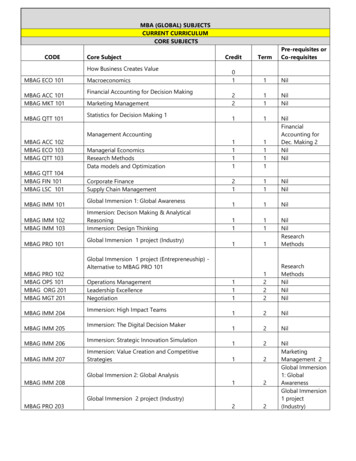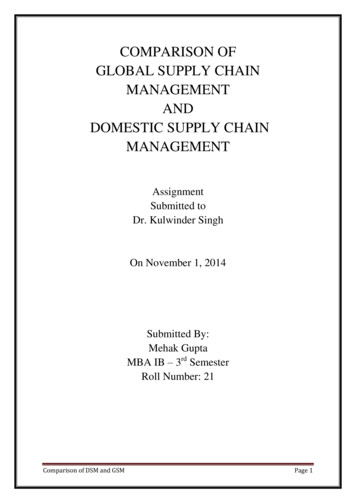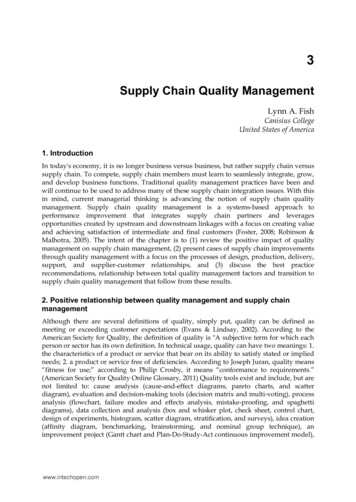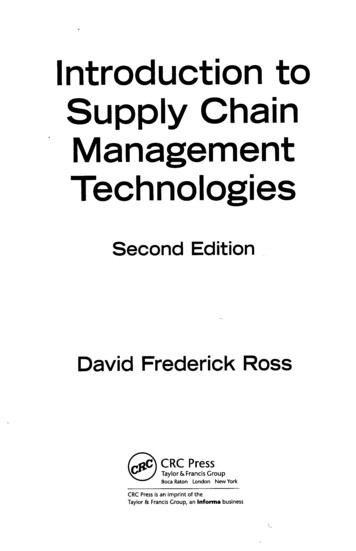
Transcription
Introduction toSupply ChainManagementTechnologiesSecond EditionDavid Frederick RossCRC PressTaylor & Francis CroupBoca Raton London New YorkCRC Press is an imprint of theTaylor & Francis Croup, an informa business
ply Chain Management: Architecting the Supply Chain forCompetitive AdvantageThe Foundations of Supply Chain ManagementThe Rise of Supply Chain Management".Historical BeginningsStages of SCM DevelopmentDefining Supply Chain ManagementDefining Logistics ManagementDefining Supply Chain ManagementRedefining Supply Chain ManagementA New SCM Definition Redefining Supply Chain ComponentsChannel ConfigurationSupply Chain CompetenciesCustomer ManagementSupplier ManagementChannel AlignmentSupply Chain CollaborationOperations ExcellenceIntegrative TechnologiesThe Impact of SCMSummary and 13133
vi Contents2Supply Chain Technology Foundations: Exploring the BasicsThe Importance of Information TechnologyBasics of Information TechnologyUsing Technology to Automate KnowledgeUsing Technology to Create KnowledgeUsing Technology to Integrate and Network KnowledgeDefining Integrative Information TechnologyEnterprise Information Technology BasicsEnterprise Technology ArchitectureEnterprise Business ArchitectureInter-Enterprise Business ArchitectureNew TechnologiesNew Generation of Technology EnablersSoftware-as-a-Service (SaaS)Wireless TechnologyGlobal Trade Management SolutionsSummary and TransitionNotes3Supply Chain System Foundations: Understanding Today'sTechnology SolutionsBusiness Information System BasicsThe Five Basic Functions of Information SystemsPrinciples of System ManagementEnterprise Business Systems FoundationsEvolution of Enterprise Business Systems (EBS)EBS System ComponentsCore Functional Areas of OperationSecondary Functional Areas of OperationEBS Networking and Integration FrameworksStandard EBS SystemsEnterprise Resource Planning (ERP)EBS Architecture for SCMEBS Benefits and RisksEBS ChoicesAdvent of Internet Business TechnologiesDefining Internet BusinessEvolution of Internet BusinessI-Marketinge-Commerce Storefronte-Business Marketplacese-Collaboration MarketplacesToday's e-Business 00104108
Contents45 viiImpact of e-Business on the Supply ChainCustomer Service-Driven ElementsSupply Chain Operations-Driven ElementsSummary and TransitionNotes109110110112114Technology-Driven Supply Chain Evolution: Building Lean,Adaptive, Demand-Driven Supply NetworksThe Lean Supply ChainAnatomy of Lean PrinciplesDefining Lean SCMSix Components of Lean Supply ChainsLean Improvement ToolsProcess StandardizationLean SCM TechnologiesCross-Enterprise CollaborationLean SCM ImplementationDemand ManagementThe Impact of Lean SCMAdaptive Supply ChainsUnderstanding Supply Chain RiskAdvent of the Adaptive Supply ChainComponents of Adaptive Supply Chain ManagementAdvantages of Adaptive Supply Chain ManagementDemand-Driven Supply NetworksDefining Demand-Driven Supply NetworksCompetencies of a DDSNDemand-DrivenDemand/Supply VisibilityAdaptive Channel ManagementLean OptimizationSupply Chain CollaborationFulfillment/Replenishment FlexibilityAdvantages of Demand-Driven Supply NetworksSummary and 57Customer and Service Management: Utilizing CRM to DriveValue to the CustomerCreating the Customer-Centric Supply ChainThe Advent of Customer Relationship Management (CRM)Mapping the Cluster of CRM ComponentsUnderstanding Today's Customer DynamicsCreating the Customer-Centric Organization159160161163166169
viii ContentsApplying Technology to CRMCRM and Internet SalesSales Force Automation (SFA)e-CRM MarketingCustomer Service Management (CSM)CRM and the Supply ChainPartner Relationship Management (PRM)Electronic Bill Presentment and Payment (EBPP)CRM AnalyticsImplementing CRMNew Concepts in Customer Management TechnologiesEmergence of Customer Experience ManagementMerging CRM and CEMRedefining CRM Technologies to Embrace CEMThe Advent of Social NetworkingDefining the Content of Social Networking TechnologiesSummary and 3196197198200202204Manufacturing and Supply Chain Planning: LinkingProduct Design, Manufacturing, and Planning to IncreaseProductivities207Manufacturing in the Age of the Global Enterprise209Demand-Driven Manufacturing211Challenges to the Manufacturing Infrastructure212Outsourcing and Supplier Partnerships214Changing Performance Targets216. The Future of Manufacturing217Impact of Technology on Manufacturing218Short History of Manufacturing Planning and Control Systems .219Geography of Today's Manufacturing Systems222Manufacturing Planning222Production and Process Management224Product Design and Engineering224Plant Maintenance and Quality Management225Product Life Cycle Management (PLM)226Impact of Internet Networking Technologies228Collaborative Product Commerce231Defining CPC231Linking Supply Chain Design Capabilities233Detailing the Contents of CPC234Managing Manufacturing Planning Functions236Advanced Production and Scheduling Systems238
Contents Accurate DataPlanning TimeframePlanning ModelSchedule ManagementSupply Chain Optimization ToolsCollaborative Planning, Forecasting, and Replenishment (CPFR)Summary and ier Relationship Management: Integrating Suppliers intothe Value Chain251Defining Purchasing and Supplier Relationship Management (SRM) .252Defining the Purchasing Function253Defining SRM255Components of SRM258Strategic Sourcing and Supply Chain Management259Applying Technology to the Management of SRM260SRM-Driven Infrastructures and Operations261The Internet-Driven SRM Environment.262e-SRM Structural Overview263EBS Backbone Functions265e-SRM Services Functions266e-SRM Processing268e-SRM Technology Services272Anatomy of the e-SRM Marketplace Exchange Environment274Emergence of Today's B2B Marketplace275Foundations276Rise of Collaborative Commerce276Development of Networked Exchanges276Defining the Trading Exchange277Future of B2B e-Marketplaces280Implementing e-SRM282e-SRM Value Discovery283Infrastructure Analysis283Preparing for Organizational Change284Spend Analysis284Item/Service Analysis284e-SRM Technology Choices285Performance Measurement286Summary and Transition287Notes289
Contents89Logistics Resource Management: Utilizing Technology toEnhance Logistics Competitive AdvantageDefining Logistics Resource Management (LRM)Logistics Performance ManagementFulfillment Planning and ExecutionLogistics Partnership ManagementShipment VisibilityFulfillment Event ManagementDealing with Logistics UncertaintiesDefining LRM in the Age of the Global InternetApplying Internet Technologies to LRMInternet-Enabled LRM TechnologiesEnterprise Performance MeasurementWarehouse ManagementTransportation ManagementUnderstanding the Third Party Logistics NetworkRole of the 3PLInternet-Driven LSPsToday's LSP Marketplace ChallengesChoosing and Implementing an LSP SolutionLSP Business ModelsSteps in LRM Strategy DevelopmentSummary and 11312315318319321323325326328330332Developing SCM Technology Strategies: Creating the Game Planfor the Successful Implementation of SCM TechnologiesChanging Views of Enterprise StrategyOverviewThe Primacy of Value ChainsBarriers to Internet-Driven SCM TechnologiesPreliminary Steps in SCM Technology Deployment StrategyOpening Issues in SCM Technology Strategy DevelopmentPreliminary StepsDeveloping the SCM Technology StrategyConstructing the Business Value PropositionDefining the Value PortfolioStructuring the Scope of CollaborationEnsuring Effective Resource ManagementPursuing Growth ManagementFocus on Supply Chain CostsFocus on Supply Chain ValueDesign an Effective Performance Measurements 69371373
ContentsSummaryNotes xi379381AfterwordNotes383386Index387
5 Customer and Service Management: Utilizing CRM to Drive Value to the Customer 159 Creating the Customer-Centric Supply Chain 160 The Advent of Customer Relationship Management (CRM) 161 . Structuring the Scope of Collaboration 360 Ensuring Effective Resource Management 366 Pursuing Growth Management 369 Focus on Supply Chain Costs 369




